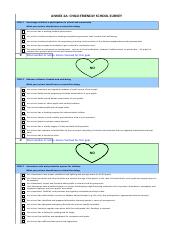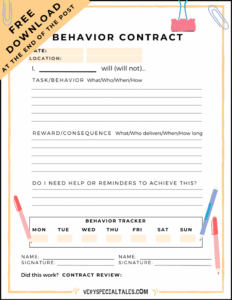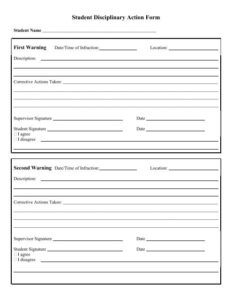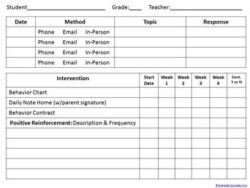Navigating the middle school years can often feel like a turbulent journey for students, parents, and educators alike. This period is marked by significant emotional, social, and academic growth, but it can also bring about behavioral challenges as young people test boundaries and seek independence. Creating a structured, supportive environment is key to helping them thrive, and one incredibly effective tool for achieving this is a well-designed behavior contract.
These agreements provide clarity and a shared understanding of expectations, empowering students to take ownership of their actions while giving adults a framework for consistent support. Far from being a punitive measure, a thoughtfully crafted behavior contract serves as a roadmap for success, fostering positive habits and self-regulation skills that will benefit students for years to come.

Why a Behavior Contract is Essential for Middle Schoolers
Middle school is a unique developmental phase where children transition from elementary school’s close supervision to preparing for the greater autonomy of high school. During this time, they are grappling with surging hormones, evolving social dynamics, and an increasing desire for independence. These factors can sometimes manifest as challenging behaviors, from disorganization and missed assignments to talking back or struggling with peer interactions. A clear, agreed-upon middle school behavior contract template becomes an invaluable asset in navigating these complexities.
Such a contract establishes a foundation of clear communication, ensuring everyone involved – the student, parents, and teachers – understands the specific behaviors expected and the consequences or rewards associated with them. This transparency reduces misunderstandings and prevents issues from escalating, creating a more predictable and less stressful environment for all. It moves away from subjective interpretations of “good” or “bad” behavior towards concrete, observable actions.
For students, a behavior contract is more than just a list of rules; it’s an opportunity to develop crucial self-management skills. By outlining their responsibilities and the goals they need to achieve, they learn accountability and the importance of making conscious choices. When they actively participate in setting these goals and understanding the impact of their actions, their motivation to adhere to the contract naturally increases.
Teachers and parents also benefit immensely from having a consistent framework. It provides a common language and a unified approach to addressing behavior, ensuring that responses are fair, predictable, and consistently applied across different settings. This consistency is vital for middle schoolers, who thrive on knowing where they stand and what is expected of them, even as they push boundaries. It also offers a tangible document for tracking progress and for discussing achievements or areas needing improvement during check-ins.
Moreover, a behavior contract can be a proactive tool, addressing potential issues before they become deeply ingrained habits. It shifts the focus from merely reacting to problems to actively shaping positive behavior through clear expectations and positive reinforcement. When designed collaboratively, it empowers the student as a partner in their own success, rather than a passive recipient of rules.
Key Components to Include
When creating your own middle school behavior contract template, there are several vital elements that should always be present to ensure its effectiveness. These components work together to provide clarity, motivation, and a pathway for growth.
* Clearly defined expectations: These should be specific, observable behaviors rather than vague statements. For example, instead of “be respectful,” consider “listen when others are speaking and use polite language.”
* Specific measurable goals: Goals should be tailored to the individual student and focus on improvement. An example might be “submit all homework assignments on time for three out of five days this week.”
* Positive reinforcement and rewards: Outline what the student will earn or receive for meeting their goals. These should be motivating and appropriate for their age.
* Consequences for not meeting goals: These should be logical, respectful, and clearly outlined beforehand. They are not punishments but rather opportunities for learning and redirection.
* Review schedule: Establish a regular time to check in, discuss progress, and make adjustments. This keeps the contract dynamic and relevant.
* Signatures: Include spaces for the student, parent, and teacher to sign, signifying their agreement and commitment to the terms.
Implementing Your Middle School Behavior Contract Template Effectively
Once you have a comprehensive middle school behavior contract template, the next crucial step is its implementation. An excellent contract can only be effective if it is put into practice thoughtfully and consistently. The process should always begin with a collaborative discussion involving the student. This is not about presenting a finished document, but rather inviting the student to contribute to its creation, ensuring they understand and feel ownership over the goals and expectations. When students have a voice in establishing the rules, they are far more likely to adhere to them.
Clarity and positivity in language are also paramount. Frame expectations in terms of what the student *should* do, rather than what they *shouldn’t*. For instance, instead of “Don’t interrupt,” try “Raise your hand and wait to be called on.” This positive phrasing encourages desired behaviors and paints a clearer picture of success. Discuss the chosen rewards and consequences in detail before the contract officially begins, making sure the student fully grasps what each entails.
Consistency is perhaps the single most important factor in the success of any behavior contract. All adults involved—parents, teachers, and any other caregivers—must commit to consistently applying the agreed-upon consequences and, crucially, providing the promised rewards. Inconsistency can quickly undermine the contract’s effectiveness and lead to frustration for everyone. Regular check-ins, as outlined in the contract’s review schedule, are essential for monitoring progress, celebrating successes, and addressing any emerging challenges or needing adjustments.
Finally, remember that a behavior contract is a living document, not set in stone. It should be flexible enough to evolve as the student grows and their needs change. Be prepared to revisit and revise parts of the contract based on observations, discussions, and the student’s progress. Celebrating small victories along the way is incredibly motivating and reinforces the positive behaviors you are trying to foster. This iterative approach ensures the contract remains relevant and supportive throughout the middle school journey.
By utilizing a well-structured behavior contract, adults can provide the guidance and boundaries necessary for middle schoolers to develop into responsible, self-aware individuals. These tools empower students to understand their role in their own learning and social environments, fostering a sense of accomplishment as they meet their goals. Ultimately, it’s about building a foundation of positive habits and respectful interactions that will serve them well into their futures.



